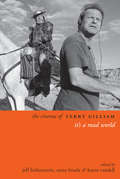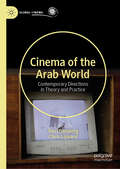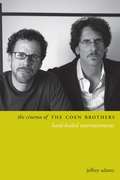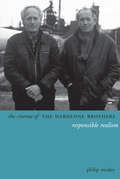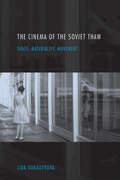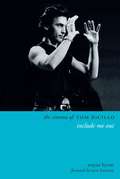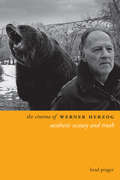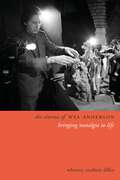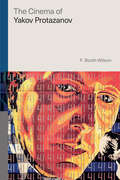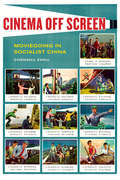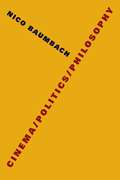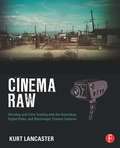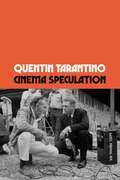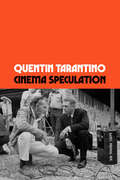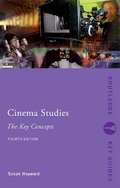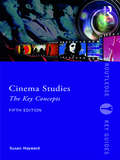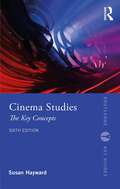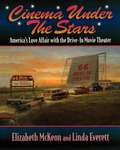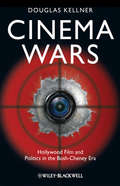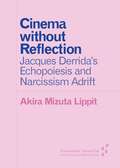- Table View
- List View
The Cinema of Terry Gilliam: It's a Mad World
by Birkenstein Jeff Anna Froula Karen RandellTerry Gilliam has been making movies for more than forty years, and this volume analyzes a selection of his thrilling directorial work, from his early films with Monty Python to The Imaginarium of Doctor Parnussus (2009). The frenetic genius, auteur, and social critic continues to create indelible images on screen--if, that is, he can get funding for his next project. Featuring eleven original essays from an international group of scholars, this collection argues that when Gilliam makes a movie, he goes to war: against Hollywood caution and convention, against American hyper-consumerism and imperial militarism, against narrative vapidity and spoon-fed mediocrity, and against the brutalizing notion and cruel vision of the "American Dream."
The Cinema of Terry Gilliam: It's a Mad World (Directors' Cuts)
by Birkenstein Jeff Anna Froula Karen Randell Eds.Terry Gilliam has been making movies for more than forty years, and this volume analyzes a selection of his thrilling directorial work, from his early films with Monty Python to The Imaginarium of Doctor Parnussus (2009). The frenetic genius, auteur, and social critic continues to create indelible images on screen--if, that is, he can get funding for his next project. Featuring eleven original essays from an international group of scholars, this collection argues that when Gilliam makes a movie, he goes to war: against Hollywood caution and convention, against American hyper-consumerism and imperial militarism, against narrative vapidity and spoon-fed mediocrity, and against the brutalizing notion and cruel vision of the "American Dream."
Cinema of the Arab World: Contemporary Directions in Theory and Practice (Global Cinema)
by Terri Ginsberg Chris LippardThis volume engages new films and modes of scholarly research in Arab cinema, and older, often neglected films and critical topics, while theorizing their structural relationship to contemporary developments in the Arab world. The volume considers the relationship of Arab cinema to transnational film production, distribution, and exhibition, in turn recontextualizing the works of acknowledged as well as new directorial figures, and country-specific phenomena. New documentary and experimental practices are referenced and critiqued, while commercial cinema is covered both as an industrial product and as one of several instances of contestation. The volume thus showcases the breadth and depth of Arab film culture and its multilayered connections to local conditions, regional affiliations, and the tendencies and aesthetics of global cinema.
The Cinema of the Coen Brothers
by Jeffrey AdamsThe films of the Coen brothers have become a contemporary cultural phenomenon. Highly acclaimed and commercially successful, over the years their movies have attracted increasingly larger audiences and spawned a subculture of dedicated fans. Shunning fame and celebrity, Ethan and Joel Coen remain maverick filmmakers, producing and directing independent films outside the Hollywood mainstream in a unique style combining classic genres like film noir with black comedy to tell off-beat stories about America and the American Dream. This study provides an overview of the films of the Coen brothers, including multiple-Oscar winning movies like Fargo and No Country for Old Men, as well as cult favorites such as O Brother, Where Art Thou? and The Big Lebowski. Beginning with the 1984 debut Blood Simple, this volume examines the development of the Coens' body of work, identifying and analyzing major themes and generic constructs and offering diverse interpretative approaches to their enigmatic films. Drawing on a wide array of sources, especially the pulp fiction of Dashiell Hammett, James M. Cain, and Raymond Chandler, this study examines the influence of these literary sources as well as key cinematic precursors to reveal how the Coens' intertextual creativity exemplifies the aesthetics of postmodernism.
The Cinema of the Coen Brothers: Hard-Boiled Entertainments (Directors' Cuts)
by Jeffrey AdamsThe films of the Coen brothers have become a contemporary cultural phenomenon. Highly acclaimed and commercially successful, over the years their movies have attracted increasingly larger audiences and spawned a subculture of dedicated fans. Shunning fame and celebrity, Ethan and Joel Coen remain maverick filmmakers, producing and directing independent films outside the Hollywood mainstream in a unique style combining classic genres like film noir with black comedy to tell off-beat stories about America and the American Dream. This study surveys Oscar-winning films, such as Fargo (1996) and No Country for Old Men (2007), as well as cult favorites, including O Brother, Where Art Thou? (2000) and The Big Lebowski (1998). Beginning with Blood Simple (1984), it examines major themes and generic constructs and offers diverse approaches to the Coens' enigmatic films. Pointing to the pulp fiction of Dashiell Hammett, James M. Cain, and Raymond Chandler, the study appreciates the postmodern aesthetics of the Coens' intertextual creativity.
The Cinema of the Dardenne Brothers: Responsible Realism (Directors' Cuts)
by Philip MosleyThe brothers Jean-Pierre and Luc Dardenne have established an international reputation for their emotionally powerful realist cinema. Inspired by their home turf of Liège-Seraing, a former industrial hub of French-speaking southern Belgium, they have crafted a series of fiction films that blends acute observation of life on the social margins with moral fables for the postmodern age. This volume analyses the brothers' career from their leftist video documentaries of the 1970s and 1980s through their debut as directors of fiction films in the late 1980s and early 1990s to their six major achievements from The Promise (1996) to The Kid with a Bike (2011), an oeuvre that includes two Golden Palms at the Cannes film festival, for Rosetta (1999) and The Child (2005). It argues that the ethical dimension of the Dardennes' work complements rather than precludes their sustained expression of a fundamental political sensibility.
The Cinema of The Dardenne Brothers: Responsible Realism
by Philip MosleyThe brothers Jean-Pierre and Luc Dardenne have established an international reputation for their emotionally powerful realist cinema. Inspired by their home turf of Liège-Seraing, a former industrial hub of French-speaking southern Belgium, they have crafted a series of fiction films that blends acute observation of life on the social margins with moral fables for the postmodern age. This volume analyses the brothers' career from their leftist video documentaries of the 1970s and 1980s through their debut as directors of fiction films in the late 1980s and early 1990s to their six major achievements from The Promise (1996) to The Kid with a Bike (2011), an oeuvre that includes two Golden Palms at the Cannes film festival, for Rosetta (1999) and The Child (2005). It argues that the ethical dimension of the Dardennes' work complements rather than precludes their sustained expression of a fundamental political sensibility.
The Cinema of the Soviet Thaw: Space, Materiality, Movement
by Lida OukaderovaFollowing Joseph Stalin’s death in 1953, the Soviet Union experienced a dramatic resurgence in cinematic production. The period of the Soviet Thaw became known for its relative political and cultural liberalization; its films, formally innovative and socially engaged, were swept to the center of international cinematic discourse. In The Cinema of the Soviet Thaw, Lida Oukaderova provides an in-depth analysis of several Soviet films made between 1958 and 1967 to argue for the centrality of space—as both filmic trope and social concern—to Thaw-era cinema. Opening with a discussion of the USSR’s little-examined late-fifties embrace of panoramic cinema, the book pursues close readings of films by Mikhail Kalatozov, Georgii Danelia, Larisa Shepitko and Kira Muratova, among others. It demonstrates that these directors’ works were motivated by an urge to interrogate and reanimate spatial experience, and through this project to probe critical issues of ideology, social progress, and subjectivity within post–Stalinist culture.
The Cinema of Tom DiCillo: Include Me Out (Directors' Cuts)
by Wayne ByrneThis volume considers for the first time in a single collection this acclaimed, award-winning director's entire oeuvre, addressing and analyzing themes such as identity, family, and masculinity, supported by in-depth coverage of the generic and aesthetic aspects of DiCillo's distinctive and influential film style. Through detailed chapters on each of DiCillo's feature films, presented here is a candid look behind-the-scenes of both the American independent film industry - from the No Wave movement of the 1980s, through the Indie boom of the 1990s, to the contemporary milieu - and the Hollywood studio system. This study documents the writing, production, and release of every DiCillo picture, each followed by an extensive Q&A with the director. Also featured are exclusive interviews and commentary with many cast members and collaborators, and members of legendary rock group, The Doors. Films covered include Johnny Suede, Living In Oblivion, Box of Moonlight, The Real Blonde, Double Whammy, Delirious, When You're Strange, and Down in Shadowland.
The Cinema of Werner Herzog: Aesthetic Ecstasy and Truth (Directors' Cuts)
by Brad PragerWerner Herzog is renowned for pushing the boundaries of conventional cinema, especially those between the fictional and the factual, the fantastic and the real. The Cinema of Werner Herzog: Aesthetic Ecstasy and Truth is the first study in twenty years devoted entirely to an analysis of Herzog's work. It explores the director's continuing search for what he has described as 'ecstatic truth,' drawing on over thirty-five films, from the epics Aguirre: Wrath of God (1972) and Fitzcarraldo (1982) to innovative documentaries like Fata Morgana (1971), Lessons of Darkness (1992), and Grizzly Man (2005). Special attention is paid to Herzog's signature style of cinematic composition, his "romantic" influences, and his fascination with madmen, colonialism, and war.
The Cinema of Werner Herzog
by Kirsten Moana ThompsonWerner Herzog is renowned for pushing the boundaries of conventional cinema, especially those between the fictional and the factual, the fantastic and the real. The Cinema of Werner Herzog: Aesthetic Ecstasy and Truth is the first study in twenty years devoted entirely to an analysis of Herzog's work. It explores the director's continuing search for what he has described as 'ecstatic truth,' drawing on over thirty-five films, from the epics Aguirre: Wrath of God (1972) and Fitzcarraldo (1982) to innovative documentaries like Fata Morgana (1971), Lessons of Darkness (1992), and Grizzly Man (2005). Special attention is paid to Herzog's signature style of cinematic composition, his "romantic" influences, and his fascination with madmen, colonialism, and war.
The Cinema of Werner Herzog
by Kirsten Moana ThompsonWerner Herzog is renowned for pushing the boundaries of conventional cinema, especially those between the fictional and the factual, the fantastic and the real. The Cinema of Werner Herzog: Aesthetic Ecstasy and Truth is the first study in twenty years devoted entirely to an analysis of Herzog's work. It explores the director's continuing search for what he has described as 'ecstatic truth,' drawing on over thirty-five films, from the epics Aguirre: Wrath of God (1972) and Fitzcarraldo (1982) to innovative documentaries like Fata Morgana (1971), Lessons of Darkness (1992), and Grizzly Man (2005). Special attention is paid to Herzog's signature style of cinematic composition, his "romantic" influences, and his fascination with madmen, colonialism, and war.
The Cinema of Wes Anderson: Bringing Nostalgia to Life (Directors' Cuts)
by Whitney Crothers DilleyWes Anderson is considered one of the most important directors of the post-Baby Boom generation, making films such as Rushmore (1998) and The Royal Tenenbaums (2001) in a style so distinctive that his films are often recognizable from a single frame. Through the travelogue The Darjeeling Limited (2007) and the stop-motion animation of Fantastic Mr. Fox (2009), his films examine issues of gender, race, and class through dysfunctional family dynamics, with particular focus on masculinity and male bonding. Anderson's auteur status is enriched by his fascination with Truffaut and the French New Wave, as well as his authorship of every one of his screenplays, drawing on influences as diverse as Mark Twain, J. D. Salinger, Roald Dahl, and Stefan Zweig. Works such as Moonrise Kingdom (2012) and The Grand Budapest Hotel (2014) continue to fascinate with their postmodern, hyper-nostalgic attention to detail. This book explores the filmic and literary influences that have helped make Anderson a major voice in 21st century "indie" culture, and reveals why Wes Anderson is one of the most inventive filmmakers working in cinema today.
The Cinema of Yakov Protazanov (Global Film Directors)
by F. Booth WilsonBest known for Aelita (1924), the classic science-fiction film of the Soviet silent era, Yakov Protazanov directed over a hundred films in a career spanning three decades. Called "the Russian D.W. Griffith" in the 1910s for his formative role in the first movies in the last years of the Russian Empire, he fled the Civil War and maintained a successful career in Europe before making an unusual decision to return to Russia now under Soviet power. There his films continued their remarkable success with audiences undergoing a bewildering and often brutal revolutionary transformation. Rather than treating him as an indistinct, if capable craftsman, The Cinema of Yakov Protazanov argues that his films are suffused with a unique creative vision that reflects both his mindset as a traditional Russian intellectual and his experience of dislocation and migration after 1917. As he adapted his films to revolutionary culture, they intermingled different voices and reinterpreted his past work from a disavowed era. Offering fresh perspectives of Protazanov’s films, the book will give readers a new appreciation of his career. The book offers a uniquely valuable vantage point from which to explore how cinema reflected a society in transformation and a seminal moment in the development of cinematic art.
Cinema Off Screen: Moviegoing in Socialist China
by Chenshu ZhouAt a time when what it means to watch movies keeps changing, this book offers a case study that rethinks the institutional, ideological, and cultural role of film exhibition, demonstrating that film exhibition can produce meaning in itself apart from the films being shown. Cinema Off Screen advances the idea that cinema takes place off screen as much as on screen by exploring film exhibition in China from the founding of the People’s Republic in 1949 to the end of the Cold War in the early 1990s. Drawing on original archival research, interviews, and audience recollections, Cinema Off Screen decenters the filmic text and offers a study of institutional operations and lived experiences. Chenshu Zhou details how the screening space, media technology, and the human body mediate encounters with cinema in ways that have not been fully recognized, opening new conceptual avenues for rethinking the ever-changing institution of cinema.
Cinema/Politics/Philosophy (Film and Culture Series)
by Nico BaumbachAlmost fifty years ago, Jean-Louis Comolli and Jean Narboni published the manifesto “Cinema/Ideology/Criticism,” helping to set the agenda for a generation of film theory that used cinema as a means of critiquing capitalist ideology. In recent decades, film studies has moved away from politicized theory, abandoning the productive ways in which theory understands the relationship between cinema, politics, and art. In Cinema/Politics/Philosophy, Nico Baumbach revisits the much-maligned tradition of seventies film theory to reconsider: What does it mean to call cinema political?In this concise and provocative book, Baumbach argues that we need a new philosophical approach that sees cinema as both a mode of thought and a form of politics. Through close readings of the writings on cinema by the contemporary continental philosophers Jacques Rancière, Alain Badiou, and Giorgio Agamben, he asks us to rethink both the legacy of ideology critique and Deleuzian film-philosophy. He explores how cinema can condition philosophy through its own means, challenging received ideas about what is seeable, sayable, and doable. Cinema/Politics/Philosophy offers fundamental new ways to think about cinema as thought, art, and politics.
Cinema Raw: Shooting and Color Grading with the Ikonoskop, Digital Bolex, and Blackmagic Cinema Cameras
by Kurt LancasterWith the next generation of raw cinema cameras you can finally shoot professionally with uncompressed raw motion pictures—without compromising your image or your budget. In Cinema Raw: Shooting and Color Grading with the Ikonoskop, Digital Bolex, and Blackmagic Cinema Cameras, Lancaster takes you through the birth of these new cameras and includes an exclusive behind-the-scenes look at Digital Bolex. He field tests each camera and discusses the importance of shooting in raw and guides you through the raw color grading process so you can create stunning films. Interviews with professionals who have shot documentaries, shorts, and promotionals with these cameras are featured throughout, allowing you to learn field production techniques under real world conditions. FEATURES: Behind-the-scenes case studies for the next generation of low budget cinema cameras Recommended gear lists to begin your raw shooting experience Full color post workflows that help you realize your boldest cinematic visions A companion website (www.kurtlancaster.com) featuring raw projects covered in the book; video interviews with the creators of the Digital Bolex, Joe Rubinstein and Elle Schneider; and resources for further study of raw cinema
Cinema Speculation
by Quentin TarantinoA unique cocktail of personal memoir, cultural criticism and Hollywood history by the one and only Quentin Tarantino.The long-awaited first work of nonfiction from the author of the number one New York Times bestselling Once Upon a Time in Hollywood: a deliriously entertaining, wickedly intelligent cinema book as unique and creative as anything by Quentin Tarantino.In addition to being among the most celebrated of contemporary filmmakers, Quentin Tarantino is possibly the most joyously infectious movie lover alive. For years he has touted in interviews his eventual turn to writing books about films. Now, with CINEMA SPECULATION, the time has come, and the results are everything his passionate fans - and all movie lovers - could have hoped for. Organized around key American films from the 1970s, all of which he first saw as a young moviegoer at the time, this book is as intellectually rigorous and insightful as it is rollicking and entertaining. At once film criticism, film theory, a feat of reporting, and wonderful personal history, it is all written in the singular voice recognizable immediately as QT's and with the rare perspective about cinema possible only from one of the greatest practitioners of the artform ever.
Cinema Speculation
by Quentin TarantinoThe long-awaited first work of nonfiction from the author of the #1 New York Times bestselling Once Upon a Time in Hollywood: a deliriously entertaining, wickedly intelligent cinema book as unique and creative as anything by Quentin Tarantino. <p><p>In addition to being among the most celebrated of contemporary filmmakers, Quentin Tarantino is possibly the most joyously infectious movie lover alive. For years he has touted in interviews his eventual turn to writing books about films. Now, with Cinema Speculation, the time has come, and the results are everything his passionate fans—and all movie lovers—could have hoped for. <p><p>Organized around key American films from the 1970s, all of which he first saw as a young moviegoer at the time, this book is as intellectually rigorous and insightful as it is rollicking and entertaining. At once film criticism, film theory, a feat of reporting, and wonderful personal history, it is all written in the singular voice recognizable immediately as QT’s and with the rare perspective about cinema possible only from one of the greatest practitioners of the art form ever. <p> <b>New York Times Bestseller</b>
Cinema Studies: The Key Concepts 4th Edition
by Susan HaywardCinema Studies: The Key Concepts is an essential guide for anyone interested in film. Providing accessible coverage of a comprehensive range of genres, movements, theories and production terms, this is a must-have guide to a fascinating area of study and arguably the greatest art form of modern times. Now fully revised and updated for its fourth edition, the book includes new topical entries such as: CGI Convergence Cult cinema Digital cinema/Post-digital cinema Dogme 95* Movement-image/Time-image Quota quickies 3-D technology
Cinema Studies: The Key Concepts (Routledge Key Guides)
by Susan HaywardCinema Studies: The Key Concepts is essential reading for anyone interested in film. Providing accessible coverage of a comprehensive range of genres, movements, theories and production terms, this is a must-have guide to a fascinating area of study and arguably the greatest art form of modern times. Now fully revised and updated for its fifth edition, the book includes entries on topics such as: Acting Audience CGI Convergence Cult cinema Digitisation and globalization Distribution Experimental film Transnational cinema World cinemas
Cinema Studies: The Key Concepts (Routledge Key Guides)
by Susan HaywardNow in its sixth edition, this essential guide for students provides accessible definitions of a comprehensive range of genres, movements, world cinemas, theories and production terms. This fully revised and updated book includes new topical entries that explore areas such as film and the environmental crisis; streaming and new audience consumption; diversity and intersectionality; questions related to race and representation; the Black Lives Matter movement; and New Wave Cinemas of Eastern European countries. Further new entries include accented/exilic cinema, border-cinema, the oppositional gaze, sonic sound and Black westerns. Existing entries have been updated, including discussion of #MeToo, and more contemporary film examples have been added throughout. This is a must-have guide for any student starting out on this fascinating area of study and arguably the greatest art form of modern times.
Cinema Under the Stars: America's Love Affair with Drive-in Movie Theaters
by Elizabeth Mckeon Linda EverettWhen Richard M. Hollingshead Jr. first projected a movie onto a white bed sheet stretched between two trees at his home in Camden, New Jersey, in 1933, little did he know that he was on the verge of creating an entirely new entertainment industry. With America just beginning its romance with the automobile, it's no surprise that the general public found this new form of movie going irresistible. Fun and affordable, the drive-in quickly gained popularity among families with young children. And, of course, the local drive-in was a favorite weekend hangout for teenagers: a place where they could go just to meet friends or take a sweetheart for a romantic evening of movies under the stars. Although drive-ins are no longer as popular as they once were, in many communities a devoted following still seeks out the open-air theaters at twilight. Cinema Under the Stars" is a reminder of those wonderful times, as well as a recounting of the history of the drive-in experience. Here is the story, and here are the memories: B movies, concession stands loaded with goodies, screen towers, ticket booths, scratchy speakers, speaker poles, and intermission. It is all here - a nostalgic look at one of America's all-time favorite pastimes. "
Cinema Wars: Hollywood Film and Politics in the Bush-Cheney Era
by Douglas M. KellnerCinema Wars explores the intersection of film, politics, and US culture and society through a bold critical analysis of the films, TV shows, and documentaries produced in the early 2000s Offers a thought-provoking depiction of Hollywood film as a contested terrain between conservative and liberal forces Films and documentaries discussed include: Black Hawk Down, The Dark Knight, Star Wars, Syriana, WALL-E, Fahrenheit 9/11 and other Michael Moore documentaries, amongst others Explores how some films in this era supported the Bush-Cheney regime, while others criticized the administration, openly or otherwise Investigates Hollywood’s treatment of a range of hot topics, from terrorism and environmental crisis to the Iraq war and the culture wars of the 2000s Shows how Hollywood film in the 2000s brought to life a vibrant array of social protest and helped create cultural conditions to elect Barack Obama
Cinema without Reflection: Jacques Derrida's Echopoiesis and Narcissim Adrift
by Akira Mizuta LippitCinema without Reflection traces an implicit film theory in Jacques Derrida's oeuvre, especially in his frequent invocation of the myth of Echo and Narcissus. Derrida's reflections on the economies of image and sound that reverberate in this story, along with the spectral dialectics of love, mirrors, and poiesis, serve as the basis for a theory of cinema that Derrida perhaps secretly imagined. Following Derrida's interventions on Echo and Narcissus across his thought on the visual arts, Akira Mizuta Lippit seeks to return to a theory of cinema adrift in Derrida's philosophy. Forerunners is a thought-in-process series of breakthrough digital works. Written between fresh ideas and finished books, Forerunners draws on scholarly work initiated in notable blogs, social media, conference plenaries, journal articles, and the synergy of academic exchange. This is gray literature publishing: where intense thinking, change, and speculation take place in scholarship.
